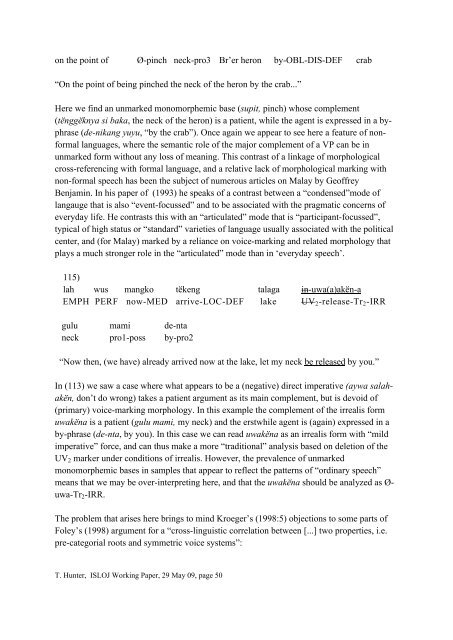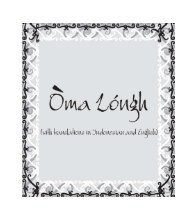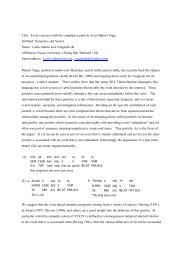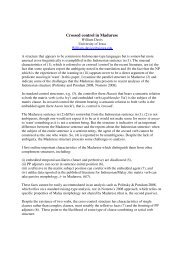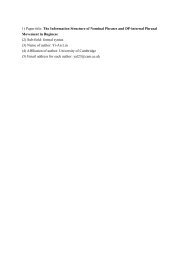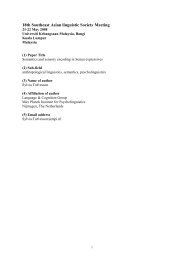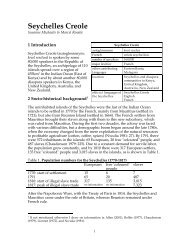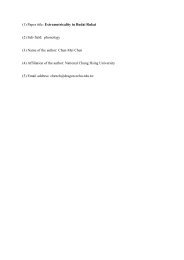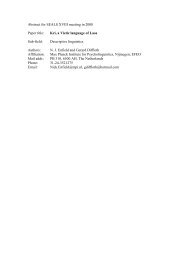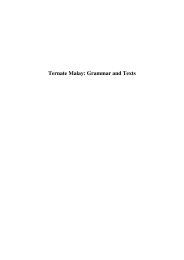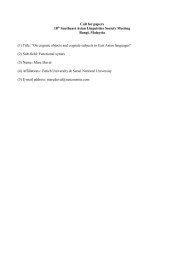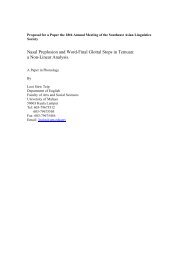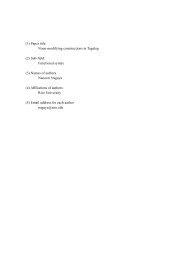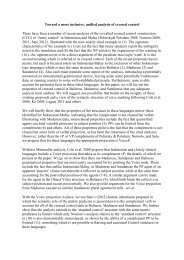Working Paper on Irrealis, Imperative Mode and Complementation ...
Working Paper on Irrealis, Imperative Mode and Complementation ...
Working Paper on Irrealis, Imperative Mode and Complementation ...
Create successful ePaper yourself
Turn your PDF publications into a flip-book with our unique Google optimized e-Paper software.
<strong>on</strong> the point of Ø-pinch neck-pro3 Br’er her<strong>on</strong> by-OBL-DIS-DEF crab<br />
“On the point of being pinched the neck of the her<strong>on</strong> by the crab...”<br />
Here we find an unmarked m<strong>on</strong>omorphemic base (supit, pinch) whose complement<br />
(tӗnggӗknya si baka, the neck of the her<strong>on</strong>) is a patient, while the agent is expressed in a byphrase<br />
(de-nikang yuyu, “by the crab”). Once again we appear to see here a feature of n<strong>on</strong>formal<br />
languages, where the semantic role of the major complement of a VP can be in<br />
unmarked form without any loss of meaning. This c<strong>on</strong>trast of a linkage of morphological<br />
cross-referencing with formal language, <strong>and</strong> a relative lack of morphological marking with<br />
n<strong>on</strong>-formal speech has been the subject of numerous articles <strong>on</strong> Malay by Geoffrey<br />
Benjamin. In his paper of (1993) he speaks of a c<strong>on</strong>trast between a “c<strong>on</strong>densed”mode of<br />
langauge that is also “event-focussed” <strong>and</strong> to be associated with the pragmatic c<strong>on</strong>cerns of<br />
everyday life. He c<strong>on</strong>trasts this with an “articulated” mode that is “participant-focussed”,<br />
typical of high status or “st<strong>and</strong>ard” varieties of language usually associated with the political<br />
center, <strong>and</strong> (for Malay) marked by a reliance <strong>on</strong> voice-marking <strong>and</strong> related morphology that<br />
plays a much str<strong>on</strong>ger role in the “articulated” mode than in ‘everyday speech’.<br />
115)<br />
lah wus mangko tӗkeng talaga in-uwa(a)akӗn-a<br />
EMPH PERF now-MED arrive-LOC-DEF lake UV2-release-Tr2-IRR<br />
gulu mami de-nta<br />
neck pro1-poss by-pro2<br />
“Now then, (we have) already arrived now at the lake, let my neck be released by you.”<br />
In (113) we saw a case where what appears to be a (negative) direct imperative (aywa salahakӗn,<br />
d<strong>on</strong>’t do wr<strong>on</strong>g) takes a patient argument as its main complement, but is devoid of<br />
(primary) voice-marking morphology. In this example the complement of the irrealis form<br />
uwakӗna is a patient (gulu mami, my neck) <strong>and</strong> the erstwhile agent is (again) expressed in a<br />
by-phrase (de-nta, by you). In this case we can read uwakӗna as an irrealis form with “mild<br />
imperative” force, <strong>and</strong> can thus make a more “traditi<strong>on</strong>al” analysis based <strong>on</strong> deleti<strong>on</strong> of the<br />
UV2 marker under c<strong>on</strong>diti<strong>on</strong>s of irrealis. However, the prevalence of unmarked<br />
m<strong>on</strong>omorphemic bases in samples that appear to reflect the patterns of “ordinary speech”<br />
means that we may be over-interpreting here, <strong>and</strong> that the uwakӗna should be analyzed as Øuwa-Tr2-IRR.<br />
The problem that arises here brings to mind Kroeger’s (1998:5) objecti<strong>on</strong>s to some parts of<br />
Foley’s (1998) argument for a “cross-linguistic correlati<strong>on</strong> between [...] two properties, i.e.<br />
pre-categorial roots <strong>and</strong> symmetric voice systems”:<br />
T. Hunter, ISLOJ <str<strong>on</strong>g>Working</str<strong>on</strong>g> <str<strong>on</strong>g>Paper</str<strong>on</strong>g>, 29 May 09, page 50


